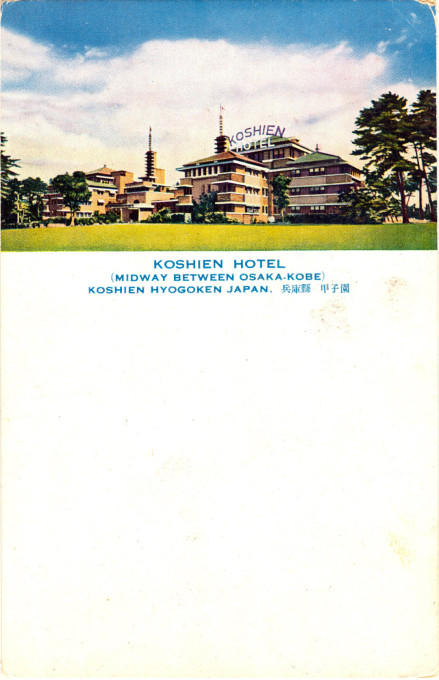“There is no center in nature – the Japanese garden, which is intended to reflect nature, has no center. There is always preparation in order to be centrifugal there.
“If architecture wants to occupy a part of nature and to become as one with it, melting into nature, the necessary preparation is to be centrifugal. Being organic and being centrifugal are inseparably related. It is almost as though to design organic architecture is to be centrifugal.”
– To Be Centrifugal, Arata Endo, 1928

Koshien Hotel, “midway between Osaka-Kobe”, c. 1930, designed by Frank Lloyd Wright disciple Arata Endo.
See also:
Imperial Hotel (1923-1968).
“But the lessons that Wright hoped to demonstrate of an ‘organic architecture’ – an architecture appropriate to time, place, and humankind – went largely unheeded as Japan struggled toward modernization in the 1920s and 1930s. Drawn by the International Style, progressive Japanese architects turned not to the United States but to Europe for inspiration.
“… Only a few architects, such as Arata Endo, Wright’s assistant on the Imperial Hotel, persevered the cause of ‘organic architecture’. His Koshien Hotel in Kobe (1930), commissioned by former Imperial Hotel manager Aisaku Hiyashi, exhibits a striking resemblance to Wright’s Midway Gardens (1913-14), and his auditorium at the Jiyu Gakuin in Tokyo (1921) reflects the influence of Taliesin itself.”
– Frank Lloyd Wright: Europe and Beyond, edited by Anthony Alofsin, 1999
From the wiki: “The Kōshien Hotel was a Mayan Revival-style hotel in Nishinomiya, between Kobe and Osaka, Japan, designed by Arata Endo, a disciple of Frank Lloyd Wright and who worked with Wright on the Imperial Hotel. The Kōshien Hotel opened in 1930. From 1944, it was used as an Imperial Navy hospital, and in 1945 it became used as accommodation for the US military for the duration of the Occupation (1945-1952).
“In 1965, it was donated to Mukogawa Women’s University, and was refurbished internally and externally. It is now known as Koshien Kaikan.
“In 1917, Endo, a 27-year-old architect and Frank Lloyd Wright enthusiast, was hired as Wright’s chief draftsman on the Imperial Hotel project. The men found they shared a kindred spirit. Just as Wright had an unorthodox Unitarian upbringing, Endo was Christian with a nonconformist bent. He, too, had an infectious wit, no tolerance for mediocrity, and a belief in the sanctity of architecture. Endo designed over one hundred and thirty buildings and wrote approximately seventy architectural articles in his lifetime.
“He designed fewer buildings between 1924-1927. During that time, Endo wrote ‘An essay on architectural art’ (1926) and ‘An essay on architecture’ (1928) to embody the nine key points he considered critical to architectural design success. The Koshien Hotel was designed right after this period. It is thought that the Koshien fully embodies and represents Endo’s philosophy on architecture at that time.”

